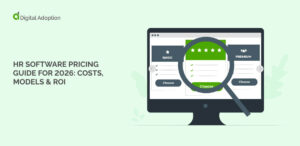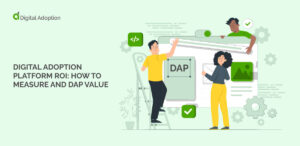You’d be forgiven for thinking the stages of digital adoption are simply:
- analogue, and
- digital.
But you’d be wrong.
And anyone else within your organization that thinks this is the case needs to be educated — and fast — otherwise the business isn’t going to be around for very long.
40% of businesses will die within a decade, unless they can successfully adopt new technologies.
So it’s imperative that you know the 3 stages of digital adoption and understand exactly what stage you’re at on the road to success.
The 3 stages of digital adoption
Stage 1: digitization
Digitization is the first of the stages of digital adoption. One would hope you’re all past this stage by now because all this stage represents is the transformation of analogue information into digital form.
Most businesses send emails rather than letters and have done for a long time, so but you’d be surprised how many analogue processes there still are in modern day enterprises.
Logging the content of meetings, for example. How many of you still take the minutes of a meeting by hand — the PA or admin assistant sits in and puts pen to paper while you talk?
No doubt she then types up those notes, or photocopies them, for distribution via email. If this is the case, you’re still in the digitization stage of digital adoption. You’re converting data into a digital format.
“Digitization essentially refers to taking analog information and encoding it into zeroes and ones so that computers can store, process, and transmit such information.”
Jason Bloomberg, Forbes
Stage 2: digitalization
The second stage is digitalization. This is actually one of the most important stages of digital adoption because it’s the moment that enterprises start using digital tools to manage entire processes.
Taking the same example as before, you’ve reached the digitalization stage when you digitize the process of taking and sharing minutes. So, you might use an app to record the meeting, transcribe the content, and store all the minutes for easy access.
This is digitalization. Though often, you’ll find that the terms digitization and digitalization are (incorrectly) used interchangeably.
They’re two very different things and until enterprises realize that, they’ve no hope of moving to stage 2 or even stage 3 of digital adoption.
| Stage | Core Focus | Example | Organizational Impact |
|---|---|---|---|
| Digitization | Converting analogue data into digital form | Scanning paper records into PDFs | Data is accessible but static |
| Digitalization | Using technology to optimize workflows | Using transcription apps for meetings | Efficiency and speed increase |
| Digital transformation | Redefining the business model using digital capabilities | Reimagining operations with AI and analytics | Innovation and cultural agility |
Stage 3: digital transformation
This is a term that is becoming extremely common in corporate circles. Everybody wants to “do” digital transformation, believing that it’s simple conversion of something that was analogue to something that is digital — like the previous stages of digital adoption.
And in a way, it is. But what you’re changing in stage 3 is your business model. That’s a little bit more complicated than meetings content.
Peter Salvitti says that digital transformation is all encompassing. It involves:
1. formal systems change,
2. political change, and
3. cultural change.
If your enterprise were a person, digital transformation would manifest in a complete overhaul of mindset, lifestyle, and values.
Now you’re starting to appreciate how few organizations can truthfully say they’re in this stage of digital adoption.
Moving between the stages to achieve digital enlightenment
The key to moving forwards through the stages is the commitment to embrace change.
The problem is that, even if the CEO or the entire leadership team wants to change and operate as a more digitally-forward business, it doesn’t mean the employees want to.
Digital commentator Rephael Sweary says:
“[Digital transformation] efforts are in vain if your employees don’t adequately engage and adopt these technologies.”
Technology is only as good as the people using it. So a critical component for moving through the stages of adoption along the road to digital enlightenment is realizing that the “usability gap” between technology and its users has to be bridged.
It won’t happen quickly and seamlessly on its own. Enterprises need to invest in making it happen.
This is where the Digital Adoption Platform (DAP) comes in. It closes the usability gap by improving the user experience of digital tools from the moment they’re switched on.
The DAP is a platform agnostic, algorithmic layer that provides guidance to users actually within the digital tool itself. So there’s no learning curve. There’s no resistance to change. And there are no limits to what your enterprise can do in terms of digital adoption.
“We digitize information, we digitalize processes and roles that make up the operations of a business, and we digitally transform the business and its strategy.”
Jason Bloomberg
Bloomberg is exactly right. And the way we move through the stages of digital adoption is by embracing change and making the user experience of digital tools as easy as possible.
Key takeaways
- Digital adoption isn’t binary; it evolves through three clear stages—digitization, digitalization, and digital transformation.
- Understanding where your organization sits on this maturity curve is essential to building a sustainable digital strategy.
- Successful digital transformation requires more than technology—it demands cultural, structural, and behavioral change.
- A Digital Adoption Platform (DAP) can bridge the usability gap, accelerating adoption and ROI from enterprise tools.
- Businesses that fail to move beyond digitization risk stagnation and eventual obsolescence in a fast-evolving digital economy.

 FACT CHECKED
FACT CHECKED







